Note: The gray boxes contain asides that provide interesting material
but can be skipped without losing the continuity of the article.
- Detroit radio executive George A. Richards bought the struggling Portsmouth Spartans for $8,000, a pittance today but a substantial sum during the Depression. The new owner moved the team to the Motor City.
- A 3-1 finish in 1933 buoyed the hopes of Reds fans in Cincinnati. But the momentum didn't carry over. After scoring a measly 10 points in their first eight games, all losses, the team folded. The league quickly obtained a replacement, the semipro St. Louis Gunners, to play out the schedule. Amazingly, the Gunners began with a 6-0 whitewash of the Pittsburgh Pirates before losing the last two games.
- Another novelty for the 1934 football season was the first College All Star game, which was held in conjunction with the World's Fair in Chicago. Started a year after the initial baseball summer classic by the same person, Arch Ward, sportswriter for the Chicago Tribune, the contest pitted a team of college all-stars against the NFL champion Chicago Bears. The game, which drew 79,432, the largest crowd to attend a sporting event that year, ended in a scoreless tie, which turned out not to be an omen since not a single NFL game in the regular season resulted in a deadlock.
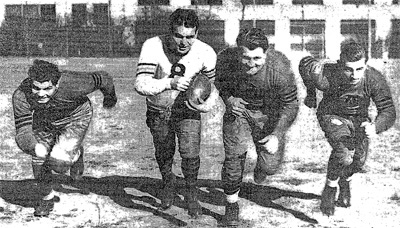
Bears backfield: Ronzani, Brumbaugh, Nagurski, Molesworth
- From October 7-14, George Halas's Bears won three games, all on the road, in eight days, including a rare Wednesday game at Pittsburgh.
- One of the reasons for the Bears' success was the fact that assistant coach Ralph Jones's offense utilized the widest assortment of formations in the league with over 150 plays. Many were run from the T formation with men in motion, an unheard of concept at the time. They outscored the opposition by exactly 200 points, 286-86.
- Halas later wrote: Our modern T-Formation with man-in-motion was the most successful strategy in football. Even so, very few coaches and players yet saw the lessons. They still continued with the wings and boxes. That was fine with me.
- The middle of the Bears line was manned by two behemoths: 268lb George Musso and Link Lyman, a mere 246. Musso would be easy to spot during the championship game because he was the only combatant without a helmet.
- The Bears came closest to defeat when they visited the Polo Grounds on November 18. They eked out a 10-9 victory over the New York Giants, whom they had beaten 27-7 at Wrigley Field two weeks earlier.

Giants Starters: RE Flaherty, RT Irvin, RG Jones, C Hein, RG Gibson, LT Morgan, LE Franklin
RH Burnett, FB Molenda, LH Strong, QB Danowski
- Because the right to host the championship game alternated between East and West as the World Series opener did between the two major leagues, the Bears traveled to New York for the December 9 meeting at the Polo Grounds. The undefeated Monsters of the Midway entered the fray as a heavy favorite, 8 to 5, to defend their championship.
- Adding to the Giants' woes, star E Red Badgro would not play because of an injury suffered in the last game of the season, a loss to lowly Philadelphia.
- Ken Strong, FB/LB/PK, the New Yorkers' best all-around player, had been badly battered as the season ended but would strive to compete for 60 minutes.
- Starting QB Harry Newman had injured a vertebrae in the Bears game three weeks earlier, knocking him out for the season. But rookie Ed Danowski from nearby Fordham had filled Harry's shoes more than adequately.
- The visitors would play without the services of HB Beattie Feathers, who set a ground-gaining record with 1,004y in 101 tries. Beattie owed his success in large measure to FB Bronko Nagurski's vicious blocking. Feathers would follow The Bronk through the line, then turn on the jets when he reached open field. When Bronk ran the ball, he didn't have a lead blocker. He's the only man I ever saw, said Giants Coach Steve Owen with deep reverence, who ran his own interference.
|
|
Mother Nature played an important role in the outcome of the championship game.
- Halas recalled: For days rain had fallen. The field was a lake. On Saturday we practiced in the mud. That night, a northeaster swept into New York. When I went to Mass, the thermometer showed 9 degrees. Street puddles had turned to ice. But the sky was clear and as the day passed the warm sun melted the ice. When we arrived at the field, the turf was spongy, with a thin topping of water.
- With the temperature barely in double digits, only 35,059 hardy souls attended, 20,000 short of the sellout expected based on ticket demand. Fans paid $3.30 for box seats, $2.20 for grandstand, and $1.10 for bleachers.
- Some wore unusual outfits, including overshoes, boots, and heavy woolen stockings worn over regular shoes. Bright scarfs and plaid blankets were seen in profusion.
- The game attracted celebrities from other sports: college coaches such as Jimmy Crowley (Fordham), Fritz Crisler (Princeton), and Lou Little of Columbia who would phone suggestions to Coach Owen on the bench. Brooklyn Dodgers skipper Casey Stengel and Mickey Cochrane, player-manager of the Detroit Tigers, represented baseball.

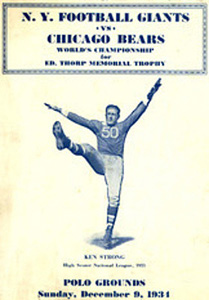
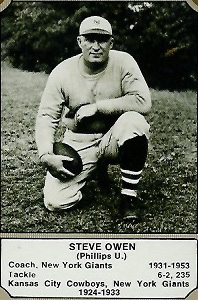
The opposing coaches
- Three hours before the 2pm kickoff, Jack Mara, Giants president and son of owner Tim Mara, inspected the field and found it better suited to hockey than football. The tarpaulin was frozen to the ground. Mara telephoned Owens to inform him about the tricky footing.
- When the players took the field for their inaptly named "warmups," several stumbled. They kicked at the turf trying vainly to get a foothold. Owens himself slipped on the ice and returned to the clubhouse in despair.
- Captain Ray Flaherty told Owens, Steve, it may sound crazy, but one day when I was playing for Gonzaga [in 1925], the ground was just like this. We switched from cleats to basketball shoes and got some traction.
- But where would you find sneakers on a Sunday morning when sporting goods stores were closed? When the Giants returned to their locker room after their futile pregame workout, Owen mentioned Flaherty's suggestion to trainer Gus Mauch (more famous as the longtime trainer of the New York Yankees of baseball). A light bulb went on in Mauch's head. His 5' assistant Abe Cohen, a tailor by trade, made Manhattan College's uniforms. So Mauch dispatched Abe to the campus (located in the Bronx) in hopes that he might find some sneakers. Unfortunately, the same ice that covered the Polo Grounds made the streets slick as well. So the trip took much longer than usual.
- One telling has Cohen taking a taxi; another puts him on the subway.
- In one version, Abe had a key to the Manhattan locker room. Another says he broke in. Still another claims that Mauch called an official at the school who was waiting when Cohen arrived.
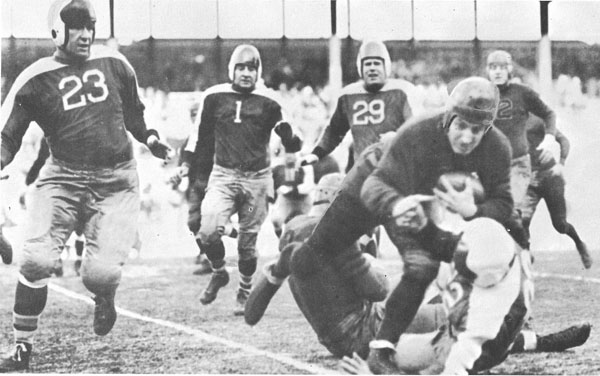
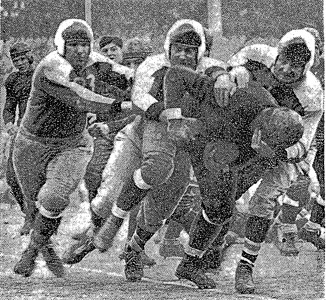
The Giants wrestle Nagurski to the ground.
- Quarter 1
NY QB Danowski worried that the bigger Bears would push right through his offensive line on the icy turf. If I go back to pass, I'll be down before I have a chance to lift my arm.
Ike Frankian intercepted Gene Ronzani's pass and lateralled to Strong on the return.
NY marched from their 36 to the Bear 9 before bogging down. So Strong booted a field goal for a 3-0 lead. Later in the period, Flaherty and Tex Irving partially blocked HB Keith Molesworth's punt. However, no points came from the opportunity.
Coach Owen sat in front of his team's bench throughout the game all by himself, nervously puffing away on a cigar.
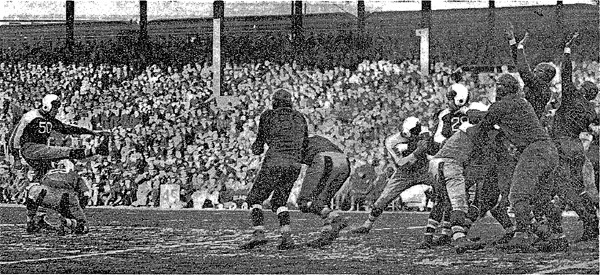
Strong boots first quarter field goal. Note the crowd in the sunshine.
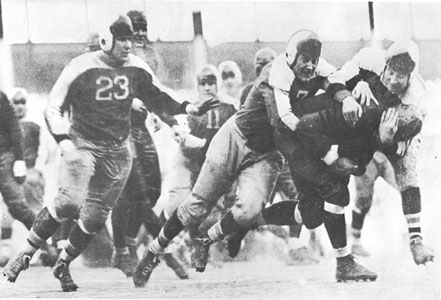
It almost always took more than one to bring Nagurski down.
- Quarter 2
Early in the period, Molesworth returned a punt 20y to the NY 37. Then Bronko Nagurski began moving, teaming with Keith for a first down on the 24. Molesworth threw a long pass which Flaherty got his hands on but couldn't corral, the ball bouncing to the Bears' Gene Ronzani on the 7. He was forced out less than a yard from the goal. Nagurski pushed through LT to put Chicago ahead. Jack Manders, the league's leading scorer with 76 points who was in the midst of a conversion streak that would reach 72, booted the PAT.
On their next possession, the Bears drove from their 43 to the 9 to set up a Manders' field goal and a 10-3 lead.
The visitors immediately received a gift when Strong fumbled the kickoff, and Bill Karr fell on the ball on the 9. Nagurski ran over LE for a touchdown, but the play was called back for offside. The Bears had to settle for another field goal try. Halas: Manders tried for a field goal and, for the first time in memory, missed. The Giants' rush caused Jack to hurry a bit.
Later, Nagurski picked up a fumble on the 6 and ran into the EZ. But the play was nullified by a holding penalty. They were still in range for Manders but he narrowly missed again from a difficult angle at the 38. I could hardly believe it, admitted Halas.
Still, the Bears left the field leading by 7 after shutting down the Giants offense following their opening drive. On the other side of the ball, as C Mel Hein said later, Nagurski was three-yarding us to death.
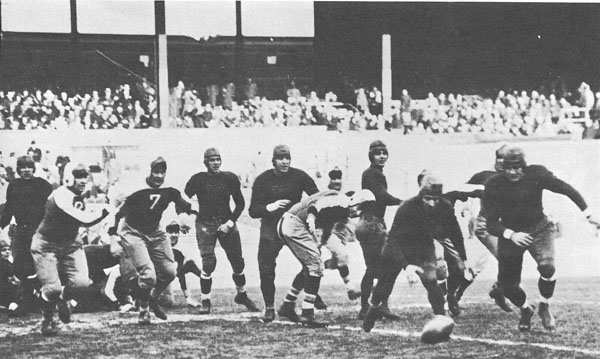
Molesworth and Nagurski (to his left) go after a fumble.
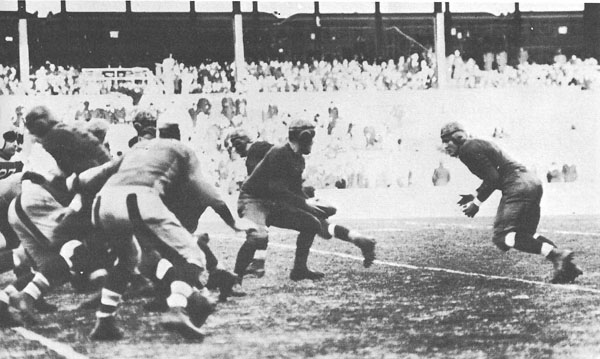
Nagurski prepares to receive Brumbaugh's handoff
- Cohen had scavenged nine pairs. The Giants' cleats, like their opponents', had broken or worn down to the nubs on the hard field in the first half.
- Strong, knocked out of the game with a leg injury when hit by Lyman in Q2 but ready to reenter after the break, put on a pair of sneakers. But many of Ken's teammates eschewed the new footwear when play resumed until they saw how easily he moved around. So more changed shoes during breaks in the action. Even a pair of sneakers that wasn't quite your size served you much better than regular cleats.
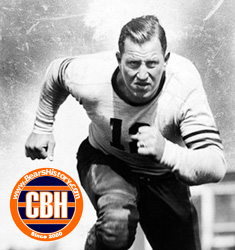
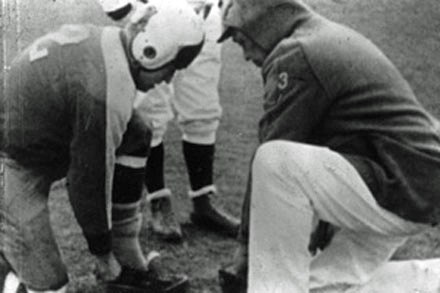
Bears T Link Lyman; Strong dons sneakers to start the second half.
The ball sailed into the end zone. We stopped laughing. We started to drive up the field as we had in the first half. We were at the sunny end but even there icy patches were starting to form. My men slipped and slid and upended. One by one Giants changed into tennis shoes.
I shouted to step on their feet. That didn't work either.
George also hollered, This ain't basketball!, and implored the referee to make the opponents put their cleats back on. But there was no rule against what the Giants were doing.
Nevertheless, the tide didn't turn right away.
- The Giants still couldn't get their offense rolling.
- The Bears extended their lead after a fumble recovery set up Manders' 23y field goal, the only scoring in Q3.
- New York finally got in gear after the kickoff. Danowski flipped passes, including two to Flaherty who made good catches. Then Danowski lateralled to Strong who rambled for 15 to the Chicago 31 as the period ended.

Danowski follows the three other backs in second half action. Note the sneakers on the Giants.
- On the first play of the final stanza, Burnett made a great catch of Danowski's aerial but fumbled. Strong was Johnny on the Spot, batting the ball out of bounds. But backup C-LB Ed Kawal stopped the advance on the next snap with a leaping interception on the 4.
- But the Giants were immediately back in business after Strong returned Molesworth's punt 15y to the 30. On the first play, Danowski fired a long pass down the middle. Carl Brumbaugh apparently made the interception over his left shoulder, but Ike Frankian wrested it away and stepped into the EZ for New York's first touchdown. Strong kicked the EP.
- The Bears still led by three but, whether they knew it or not, they were doomed. E Luke Johnsos recalled, Some players took off their shoes. That helped a little but not much. I kept my shoes on. I had holes in my socks. We just flipflopped around. The Giants could go anywhere they wished.

Molesworth (far right) passes just before Morgan hits him, causing an interception. Note the large patch of ice.
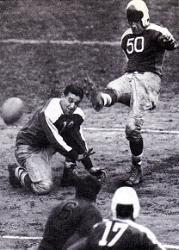 Strong boots PAT. Note helmet of holder Harry Newman in background. |
The Bears could go nowhere and were forced to kick.
The next play perfectly illustrated the advantage of the sneakers.
|
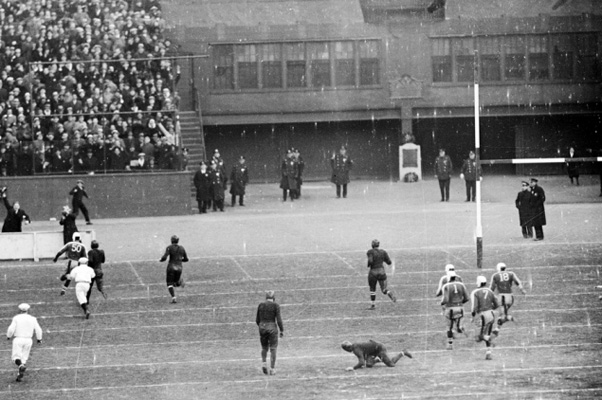
Strong crosses the goal on his 41y run to put the Giants ahead.
- With no need to panic, the Bears gave the ball to Nagurski seven times for 37y to the NY 35 where they faced 4th and 2. The Bronk got the call up the middle one more time, but he slipped as he took the handoff, and Morgan, playing the game of his life, hurled him backwards.
- The Big Apple Boys moved into scoring position on a brilliant 20y run around RE to the 11 by Danowski behind the excellent blocking of Strong and FB Bo Molenda. (Sneakers aided blockers as much as runners.) Strong did the honors again, this time knifing off RE on a reverse - an unthinkable play in the first half - and cutting back behind more fine interference. The PAT try failed when Molenda dropped the pass from C. He tried a dropkick that was blocked.
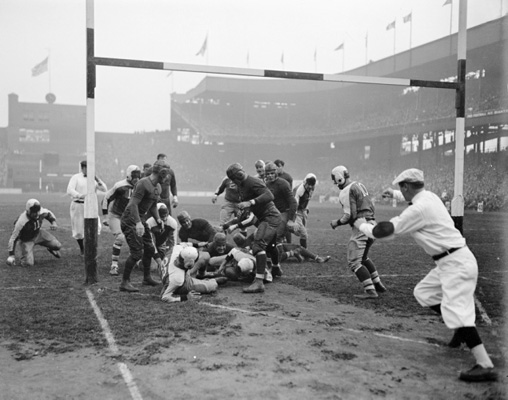
Strong scores again.
- The Giants' final touchdown was made possible by LB Molenda's interception of Ronzani's pass on the first play after the kickoff. Bo lateralled to Burnett who ran 12y to the Chicago 22. Danowski punched out 10, then went off RE on the next play to cross the goal standing up. Molenda's PAT added the icing on the cake of what New York Times writer Robert Kelley called one of the most amazing comebacks in the history of the game.
- The final minutes were interrupted by hats soaring onto the field and hundreds of chilled fans streaming over the retaining walls. New York tallied 27 points in the final 15 minutes to win going away, 30-13.
- It came to light later that the Giants enjoyed another edge in the game. With the water buckets frozen, Mauch substituted swigs of whiskey from paper cups during timeouts to warm up his charges.
The last five minutes of the game presented a weird spectacle as described by Howard Roberts in The Chicago Bears (1947).
- The west goal posts lasted exactly two minutes after the game. The fans swooped down and tore them apart for souvenirs.

- The jubilant players pummeled one another and let out one wild whoop after another.
- Owen: I'm glad for the boys; they overcame a lot of handicaps this year. Losing regulars like Harry Newman and Red Badgro and then coming back to win certainly shows courage, and they deserve a lot of credit. Bill Morgan played the finest game at tackle I've ever seen.
- When asked his hardest assignment of the day, Morgan replied: Getting through the crowd into the dressing room.
- Owner Tim Mara: I never was so pleased with anything in all my lilfe. In all the other contests with the Bears, I always have hoped the whistle would blow and end the game. Today I was hoping it would last for a couple of hours.
- Strong, who finished with 94y on just nine carries, said the line won the game. Any back can run through a hole. Ken was also gracious toward the Bears: If they'd had new cleats in the second half, they would have walloped us.
- Little Abe Cohen congratulated Strong. Ken, I want to congratulate you. You played a wonderful game.
But Strong replied, Abe, you're the man who won this game. You deserve the write-ups.
- Halas: They deserved to win because they played a great game in that second half. The only bad break we got was when that touchdown was called back in the first half. It would have made the score 17-3 and put us way out in front. My team was under a terrific strain, however, trying to maintain a winning streak which extended over 31 games. After all, we've caused a lot of heartaches; so I suppose we can stand one ourselves.
- Nagurski: We feel that every one has to lose some time, but this is a pretty hard time to start. The Giants, though, were a fine ball team and their comeback in that second half was the greatest ever staged against us. Ken Strong I thought the best man on the field, and Danowski gave a nice exhibition. Morgan was a hard man to try to pass while Mel Hein did a good job of backing-up. ... They won it with the sneakers. They could cut back and we couldn't.
All of New York City rejoiced except possibly the Manhattan equipment manager when the Giants returned his battered, misshapen sneakers the next day.
The game grossed $64,504. After deducting for taxes, the players' pool provided each member of the winning team with $621 and each Bear with $414. Each club earned $8,775.40 while the league pocketed $5,850.36.
Postscript #1
To make some more money, the Giants and Bears met on January 27 in Los Angeles for an exhibition game.
- With no ice, Chicago won easily, 21-0.
- It was the last game for the immortal Red Grange, who retired after eight seasons of pro ball.
Postscript #2
References: Championship: The NFL Title Games plus Super Bowl, Jerry Izenberg (1970)
Halas by Halas: The Autobiography of George Halas (1979)
100 Yards of Glory: The Greatest Moments in NFL History, Joe Garner and Bob Costas (2011)
The Chicago Bears, Howard Roberts (1947); The First Fifty Years, NFL Properties, Inc. (1969)
The 50 Greatest Plays in New York Giants Football History, John Maxymuk (2010)
Pro Football's Rag Days, Bob Curran (1969)
Top of Page